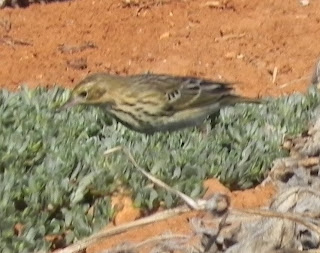Lake Gaberon, late March 2010 Photo by Erika Sigvallius
Pictures of birds in the Libyan Sahara are few and far between. I hope to visit there as soon as it cools down from today's 40C highs. Previously, I have posted some pictures in an article called "Kufra and the deep south (January 2010)".
This blog compiles two small sets of pictures taken in two separate years but at the same time of year - the last week of March. These are thanks to a web site devoted to eclipse followers - ecliptomanics who followed the 2005 total eclipse of the sun http://www.ecliptomaniacs.com and a friend and ex-teaching colleague Erika Sigvallius who took some snaps in March this year and which I received a couple of days ago.
Most tourists in the Libyan desert visit the Ubari chain of lakes west of Sebha. I wonder how many look closely at the birds. The picture below is a close-up of the lead picture. It reveals a small flock of black-winged stilt. This bird breeds, passes though and winters in various parts of Libya. It is probable these are migrants passing north.
flock of black winged stilt, Lake Gaberon, March. Photo by Erika Sigvallius
While Lake Gaberon is one of the most common places that tourists visit, the white crowned wheatear is the most common bird they see. It is the definitive Libyan desert bird. if you see it you are in the desert. If don't, you aren't.
white crowned wheatear, near Ubari lakes, March 2005. Photo by ecliptomanics
Probably the easiest place to see desert sparrow in the Sahara is along the Ubari lakes. These nomadic birds are a pretty much guaranteed sight there.
desert sparrow, near Ubari lakes, March 2005, photo by ecliptomanics
Desert wheatear is also relatively common there. Both it and white crowned wheatear are resident breeders.
desert wheatear, near Ubari lakes, March 2005, Photo by ecliptomanics
Another fairly easily seen bird is turtle dove. In coastal Libya it is a summer breeder which migrates south for the winter. In Saharan Libya many birds are resident so they can be seen all year round.
turtle dove, near Ubari lakes, March 2005. Photo by ecliptomanics
I have some local knowledge now because two of my colleagues - Jane and Sam who I worked with in Tripoli now work in Sebha. They say two of the best places for birds in Sebha itself are the hospital gardens (where they work) and the zoo.
Erika noticed a very large number of nests in the trees at the zoo when she visited it in March. I have identified the birds as spanish sparrow. This bird seems to be spreading. Is this their most southerly outpost in the world?
spanish sparrow nests, Sebha zoo. Photo by Erika Sigvallius
I have blown up part of one picture to show you a spanish sparrow.
spanish sparrow, Sebha zoo, March 2009. Photo by Erika Sigvallius
I can't wait for the cooler weather. I am praying for it to cool down before all the passage birds have gone from the desert areas. But even if it doesn't happen there will plenty of good birding down south.





















































